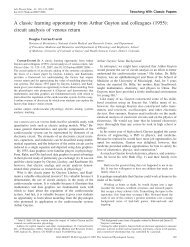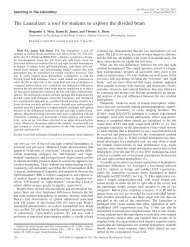construction of a model demonstrating neural pathways and reflex arcs
construction of a model demonstrating neural pathways and reflex arcs
construction of a model demonstrating neural pathways and reflex arcs
You also want an ePaper? Increase the reach of your titles
YUMPU automatically turns print PDFs into web optimized ePapers that Google loves.
I N N 0 V A T I 0 N S A N D I D E A S<br />
in the spinal cord by interneurons that inhibit<br />
antagonist muscles.<br />
2) Withdrawal <strong>reflex</strong> upon painful stimulus. The<br />
withdrawal <strong>reflex</strong> is an important protective <strong>reflex</strong>.<br />
This <strong>reflex</strong> prevents excessive injury to the body. The<br />
withdrawal <strong>reflex</strong> is used when you step on some-<br />
thing sharp or when you touch something hot. Your<br />
first reaction to painful stimuli like these is to with-<br />
draw your h<strong>and</strong> or leg or flex it away from the<br />
stimulus. This happens very rapidly, even before your<br />
brain can sense the pain.<br />
The withdrawal <strong>reflex</strong> is a polysynaptic one, but it can<br />
be broken down into basic components. One part <strong>of</strong><br />
the withdrawal <strong>reflex</strong> causes your arm or leg to flex<br />
away from the <strong>of</strong>fensive stimulus. This part is similar<br />
to the patellar tendon <strong>reflex</strong>; a schematic representa-<br />
tion <strong>of</strong> the components <strong>of</strong> the withdrawal <strong>reflex</strong> is<br />
found in Fig. 14. It is important to note that, while the<br />
muscular component <strong>of</strong> the withdrawal <strong>reflex</strong> is<br />
similar to the patellar tendon <strong>reflex</strong>, it differs because<br />
it is a polysynaptic <strong>reflex</strong> involving an interneuron.<br />
The other part <strong>of</strong> the <strong>reflex</strong> involves a sensory<br />
awareness <strong>of</strong> a painful sensation. Further processing<br />
<strong>of</strong> this information leads to learning <strong>and</strong> memory.<br />
THE REFLEX. In the withdrawal <strong>reflex</strong>, sensory receptors<br />
receive the “painful” stimulus. This information is<br />
carried by afferent (sensory) neurons into the spinal<br />
I<br />
synapse<br />
cord. In the spinal cord, the information is passed by<br />
an interneuron to the efferent (motor) neuron. The<br />
efferent (motor) neuron carries its information out to<br />
the muscle to cause flexion <strong>of</strong> the limb away from the<br />
stimulus.<br />
Again, because muscles work in functional pairs, the<br />
group <strong>of</strong> muscles that works to extend your arm or leg<br />
is inhibited. Muscles are inhibited when the nerves to<br />
them are inhibited. Motor neurons receive their infor-<br />
mation from nerves in the spinal cord. This is the same<br />
mechanism as the patellar tendon <strong>reflex</strong> except that it<br />
is for a flexor muscle <strong>and</strong> not an extensor one. Also, it<br />
is polysynaptic <strong>and</strong> involves an interneuron to link the<br />
sensory (afferent) <strong>and</strong> motor (efferent) neurons.<br />
INVOLVING THE BRAIN. Information causing the <strong>reflex</strong><br />
portion <strong>of</strong> the withdrawal <strong>reflex</strong> enters <strong>and</strong> exits at<br />
the same level <strong>of</strong> the spinal cord. Additionally, the<br />
information reaches the brain through an ascending<br />
tract.<br />
The information coming from the afferent (sensory)<br />
neuron reaches the spinal cord. When it enters the<br />
spinal cord, the information about pain hops through<br />
one synapse, its destination: the neurons in the tract<br />
that carry pain, temperature, <strong>and</strong> deep touch sensa-<br />
tions. The tract ascends to the thalamus where it<br />
synapses again. Then, the information is relayed to the<br />
correct region <strong>of</strong> the cerebral cortex.<br />
I<br />
synapse<br />
synapse<br />
3<br />
target<br />
muscle<br />
that flexes<br />
away from<br />
<strong>of</strong>fending<br />
pain<br />
FIG. 14.<br />
Schematic <strong>of</strong> <strong>reflex</strong> arc components involved in withdrawal <strong>reflex</strong>. A sensory receptor in the skin receives<br />
the pain stimulus <strong>and</strong> transmits it to the afferent (sensory) neuron. There is a synapse between the<br />
afferent neuron <strong>and</strong> the interneuron or association neuron. There is another synapse between the<br />
interneuron <strong>and</strong> the efferent (motor) neuron. This makes the <strong>neural</strong> circuit a polysynaptic one.<br />
Information from the efferent neuron is transmitted to the target muscle also by a synapse.<br />
VOLUME 16 : NUMBER 1 - ADVANCES IN PHYSIOLOGY EDUCATION - DECEMBER 1996<br />
S29









